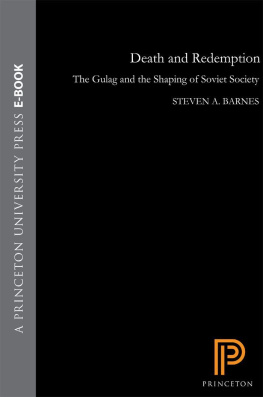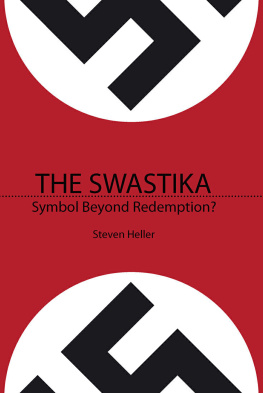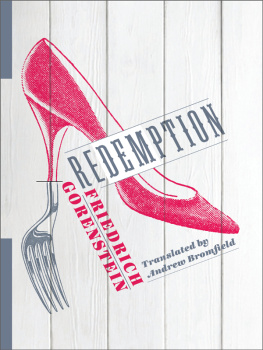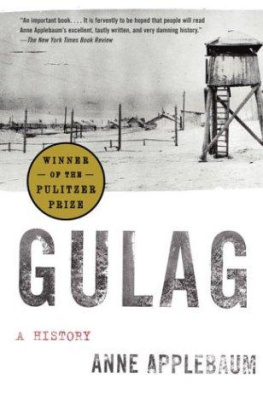Steven A. Barnes - Death and Redemption: The Gulag and the Shaping of Soviet Society
Here you can read online Steven A. Barnes - Death and Redemption: The Gulag and the Shaping of Soviet Society full text of the book (entire story) in english for free. Download pdf and epub, get meaning, cover and reviews about this ebook. year: 0, publisher: Princeton University Press, genre: History. Description of the work, (preface) as well as reviews are available. Best literature library LitArk.com created for fans of good reading and offers a wide selection of genres:
Romance novel
Science fiction
Adventure
Detective
Science
History
Home and family
Prose
Art
Politics
Computer
Non-fiction
Religion
Business
Children
Humor
Choose a favorite category and find really read worthwhile books. Enjoy immersion in the world of imagination, feel the emotions of the characters or learn something new for yourself, make an fascinating discovery.
- Book:Death and Redemption: The Gulag and the Shaping of Soviet Society
- Author:
- Publisher:Princeton University Press
- Genre:
- Year:0
- Rating:5 / 5
- Favourites:Add to favourites
- Your mark:
- 100
- 1
- 2
- 3
- 4
- 5
Death and Redemption: The Gulag and the Shaping of Soviet Society: summary, description and annotation
We offer to read an annotation, description, summary or preface (depends on what the author of the book "Death and Redemption: The Gulag and the Shaping of Soviet Society" wrote himself). If you haven't found the necessary information about the book — write in the comments, we will try to find it.
Death and Redemption: The Gulag and the Shaping of Soviet Society — read online for free the complete book (whole text) full work
Below is the text of the book, divided by pages. System saving the place of the last page read, allows you to conveniently read the book "Death and Redemption: The Gulag and the Shaping of Soviet Society" online for free, without having to search again every time where you left off. Put a bookmark, and you can go to the page where you finished reading at any time.
Font size:
Interval:
Bookmark:
DEATH AND REDEMPTION
The Gulag and the Shaping of Soviet Society
STEVEN A. BARNES
PRINCETON UNIVERSITY PRESS
PRINCETON AND OXFORD
Copyright 2011 by Princeton University Press
Published by Princeton University Press, 41 William Street, Princeton, New Jersey 08540 In the United Kingdom: Princeton University Press, 6 Oxford Street, Woodstock, Oxfordshire OX20 1TW
press.princeton.edu
All Rights Reserved
Library of Congress Cataloging-in-Publication Data
Barnes, Steven Anthony.
Death and redemption : the Gulag and the shaping of Soviet society / Steven A. Barnes.
p. cm.
Includes bibliographical references and index.
ISBN 978-0-691-15108-3 (hardcover : acid-free paper)
ISBN 978-0-691-15112-0 (pbk. : acid-free paper)
1. Glavnoe upravlenie ispravitelno-trudovykh lagerei OGPUHistory. 2. GULag NKVDHistory. 3. Concentration campsSoviet UnionHistory. 4. Concentration campsSocial aspectsSoviet UnionHistory. 5. PrisonsSoviet UnionHistory. 6. PrisonsSocial aspectsSoviet UnionHistory. 7. Political prisonersSoviet UnionSocial conditions. 8. PrisonersSoviet UnionSocial conditions. 9. Forced laborSocial aspectsSoviet UnionHistory. 10. Soviet UnionSocial conditions. I. Title.
HV9712.B27 2011
365'.4509470904dc22 2010047824
British Library Cataloging-in-Publication Data is available
This book has been composed in Sabon
Printed on acid-free paper.
Printed in the United States of America
10 9 8 7 6 5 4 3 2 1
TO ERIKA
A book can never be completed without support and assistance from many sources. I would especially like to thank my doctoral adviser and friend, Amir Weiner, for his patience, valuable advice, and critique at every stage of the project. The final revisions would have never been finished without the expertise and advice of my mentor, colleague, and best friend at George Mason University, Rex Wade. Finally, special thanks goes to my graduate school colleague and longtime friend Andrew Jenks, who has challenged and sharpened my thinking over many years.
My research and writing was generously supported by Stanford Universitys Department of History, George Mason Universitys Department of History, the Anatole Mazour fund, the International Research Exchanges Board, the Giles Whiting Foundation, the Social Science Research Council, the MacArthur Consortium in International Peace and Cooperation coordinated by the Center for International Security and Cooperation at Stanford University, the Davis Center for Russian and Eurasian Studies at Harvard University, the Kennan Institute at the Woodrow Wilson International Center for Scholars, the Virginia E. Hazel Research Leave fund at George Mason University, and the Allen and Gwen Nelson Junior Faculty Research fund at George Mason University. Thanks also to the National Endowment for the Humanities for its support of the http://gulaghistory.org Web site, which now houses many documents used in this study.
Alma Sultangalieva, Kaidar Aldazhumanov, Zhambyl Artykbaev, and Diusetai Shaimukhanov were absolutely critical in generously smoothing the path to archival access in Kazakhstan. I am especially grateful to the underpaid and overworked staff of all the Russian and Kazakhstani archives used in the present study. Thanks also to the library and archives at the Hoover Institution on War, Revolution, and Peacea resource without parallel.
Stephen Kotkin graciously offered valuable advice at the projects earliest stages. Numerous other colleagues have provided intellectual critique and emotional support. My thanks to Norman Naimark, Terrence Emmons, Robert Crews, Katherine Jolluck, Lynne Viola, Claudia Verhoeven, Steven Harris, Matthew Romaniello, Charles Lipp, Cynthia Hooper, Miriam Dobson, Margaret Paxson, Yuri Slezkine, Elizabeth Wood, Jehanne Gheith, Pamela Kachurin, Golfo Alexopoulos, Ron Suny, Alexandru Lesanu, Eric Lohr, Richard Stites, Michael David-Fox, David Nordlander, Paula Michaels, Liz Tarlow, Penny Skalnik, Elizabeth Wood, Vladimir Brovkin, Stuart Finkel, Paul Stronski, and Ann Livschiz. The anonymous readers for Princeton University Press offered challenging and helpful critique.
Special appreciation to all those who got me involved in the public and digital history of the Gulag, and helped me learn how to present the topic to a general audience. I hope this has found its way into my book. Thanks to Louis Hutchins, Marty Blatt, Viktor Shmyrov, Tatiana Kursina, Oleg Trushnikov, Roy Rosenzweig, Dan Cohen, Tom Scheinfeldt, Elena Razlogova, Stephanie Hurter, Gwen White, Anastasia Mikheeva, Sheila Brennan, Jeremy Boggs, Mikhail Vinokur, and David Hosford.
Participants in Stanfords Russian and East European history workshop read drafts of several chapters and offered valuable advice. Various parts of the text benefited from the participants in the Washington, DC, Russian history workshop as well as from workshops and conferences at the University of Maryland, the University of Chicago, the School of Slavic and East European Studies at University College London, Duke University, the University of North Carolina at Chapel Hill, the University of California at Berkeley, Miami University in Ohio, the University of Toronto, Harvard University, and the University of Hawaii.
From the first day to the final printing, the assistance of the staff of the history departments at Stanford and George Mason was crucial. Special thanks goes to Monica Wheeler, Gertrud Pacheco, and Lynn Kaiser at Stanford, and Laura McCloskey, Sharon Bloomquist, Susie LeBlanc, and Carrie Grabo at George Mason.
The responsibility for the content is, of course, entirely my own.
Finally, thanks to my parents and my wife, Erika, for their personal support; to my two daughters, Julia and Emma; to the Don, the Doc, and the Bird for laughter unending; to Ron Shults for fostering in me a love of books; and to Vitalii and Iuliia Kapinos for the special friendship that made my time in Karaganda better than bearable.
DEATH AND REDEMPTION

Maps of Kazakhstan (above) and the Soviet Union (top). City names given according to post-Soviet usage and with Russian spelling (earlier historical names provided in parentheses). Maps drawn by Stephanie Hurter.
In One of the Telling Episodes of his history of the Gulag, Aleksandr Solzhenitsyn relates the tale of a prisoner ship convoy headed for the Dalstroi goldfields of the notorious Kolyma. As the convoy approached Magadan, the ships got stuck in the icy waters of the Kolyma River. The prisoners were forced to disembark and walk across the frozen river to the shore. Solzhenitsyn continues:
Nonetheless, continuing to play out the farce of correction, in other words, pretending they had brought not simply bones with which to pave the gold-bearing Kolyma but temporarily isolated Soviet citizens who would yet return to creative life, they were greeted by the Dalstroi orchestra. The orchestra played marches and waltzes.
What could possibly seem more out of place than an orchestra trumpeting the arrival of a prisoner convoy into the depths of the Gulag?
In 1950, the American Alexander Dolgun sat outside the gates of the Steplag labor camp in the Karaganda region of Kazakhstan. His welcome to the camp was almost surreal.
I began to feel as though I was hallucinating again because I could hear music, a band, playing some kind of bravura march. It sounded weak and the instruments were not well tuned, but the rhythm was fast and I was sure it was coming from inside the gate. I had a sense of deep cosmic horror that made me dizzy. In the distance I could see the silhouette of the corpses on the wagon. The band seemed to be playing some kind of grotesque farewell. Then it got worse. Out of the gate came, in lines of five abreast, a column of
Next pageFont size:
Interval:
Bookmark:
Similar books «Death and Redemption: The Gulag and the Shaping of Soviet Society»
Look at similar books to Death and Redemption: The Gulag and the Shaping of Soviet Society. We have selected literature similar in name and meaning in the hope of providing readers with more options to find new, interesting, not yet read works.
Discussion, reviews of the book Death and Redemption: The Gulag and the Shaping of Soviet Society and just readers' own opinions. Leave your comments, write what you think about the work, its meaning or the main characters. Specify what exactly you liked and what you didn't like, and why you think so.







